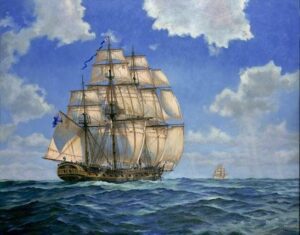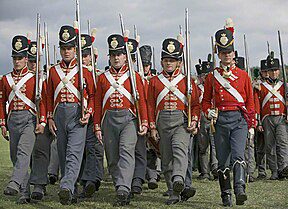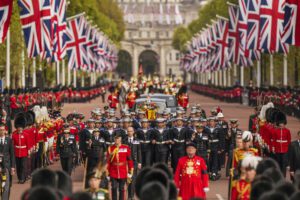
In America, the British army that occupied the colonies and fought against American patriots in the Revolutionary War are forever known as “redcoats.” Obviously, this name is derived from the red or scarlet upper garment that most of the British soldiers wore. Many would say that red made the soldier a better target, but the British wore red for about 250 years. This article is because of my curiosity about the origin of the British red coats. When and why did they adopt the red coats? Did all types of units wear red? Did all ranks wear red? I hope this article answers all these questions plus a few I did not think of.
Before the introduction of firearms to the battlefield, body armor was used by any soldier that could afford it. The armor ranged from the full body suits that aristocrat knights used. They made up the feared heavy cavalry. The common soldier was lucky if he could afford a breast plate.
Armor was important until the mid-16th century to early 17th century when firearms came into widespread use with guns that were plentiful and simple to operate. Since the projectile fired from a firearm easily penetrated body armor, mounted and heavily armored knights became obsolete. The elimination of metal body armor resulted in armies developing distinctive cloth uniforms.
Another important change was that firearms could be used effectively by nearly anyone, so mercenaries were no longer needed, and the ranks became filled with trained commoners. Officer ranks continued to be mostly filled with aristocrats. The introduction and development of firearms had more impact on warfare than any other advance for nearly a thousand years.

The English had a history of red military clothing long before it became the official color. The Yeomen of the Guard and the Yeomen Warders were both formed in 1485 and wore Tudor red and gold. The Gentlemen Pensioners of King James I (Reign 1603-1625) wore red. In the first battle of the English Civil War, Royalists troops wore red as did at least two Parliamentary units.
The English fighting in Ireland during the reign of Elizabeth I (Reign 1558-1603) wore red and were often referred to as “red coats.” by the Irish. During the Anglo-Spanish War, the English pike men and arquebusiers (arquebus is matchlock firearm) fighting with their Dutch allies wore red cassocks.
The English red coat was officially adopted in February 1645 when the English Parliament passed the “New Model Army Ordnance.” The new English Army paper strength was 22,000 men – 11 cavalry regiments of 600-men each; 12 infantry regiments of 1,200 men each; one 1,000-man dragoon regiment; and 900 artillery men. The infantry regiments were to wear Venetian red coats with white, blue, or yellow facings.
Many people believe red just made the soldier more visible, but it did not. The firearms of the day were very inaccurate so the British began to fight in lines to concentrate their fire. The soldiers just pointed their muskets at the enemy. They advanced shoulder-to-shoulder to a range of about 60 yards, and on command stopped and raised their muskets and all fired on command. They knelt to reload and the next rank would fire. They advanced relentlessly toward the enemy.
Black powder produces copious amounts of acrid smoke which obscured the battlefield, but the red coats stood out. This allowed British officers to maintain better control of the situation, which gave them the advantage.
The English red coat made its continental European battlefield debut in 1658 at the Battle of the Dunes. The English troops had arrived at the port of Calais the previous year and “every man had a new red coat and a new pair of shoes.”
The English proved their mettle by storming 150-foot-high sand dunes that were defended by experienced Spanish soldiers positioned on the crests of the dunes. The English pushed the Spaniards from the crests with musket fire and pikes. I can only imagine how hard it must have been to scale a sand dune while under fire.
After the Restoration in 1660, red continued to be worn by English infantry. However, this was the result of circumstances rather than policy. The cost of the dye was relatively cheap and the color was “fast” and did not fade much. Grey and blue coats were also being worn while the military was being reorganized.
On 16 January 1707, a royal warrant established the “Board of General Officers” to regulate the clothing of the army and uniforms had to conform to their instructions. The design of the coats tended to be based on those of European armies. In 1747, regulations were issued to set the color of facings of the long coat to identify regiments. The red long coat was to be worn with a white or buff colored waistcoat.

By the time of the American Revolution, Britain had conquered territory that spanned the globe, with prominent colonies in the Caribbean, North America, and India. It had vast wealth, strengthened by trade, and protected by a powerful navy and a professional army. Although the British army was powerful. It was not yet among the most powerful and the navy did not yet “rule the seas.” During the reign of Victoria (1837-1901), they reached their zenith with a vast empire, and they held most of it until World War II.
In the cultural memory of the United States, it was “redcoats” that fought against the Patriots during the War for Independence, but at the time, the British were referred to as “Regulars” or “King’s Men” in most accounts. Most British infantry wore the long red coat, but German mercenaries and some Loyalist units wore green or blue uniforms.
Other names for the British military included “bloody backs” which referred to the color of their coats and to the use of flogging for punishment for military offenses. In the Boston area the British were often referred to as “lobsters.”
The term “redcoat” was used colloquially, and George Washington was known to use the term in personal letters. My favorite use of the term was by Continental Major General John Stark. Before the 16 August 1777 Battle of Bennington, New York, Stark reportedly said to his troops: “There are your enemies, the Red Coats and the Tories. They are ours, or this night Molly Stark sleeps a widow.” Stark scored a decisive victory.
During the Revolution, the British still wore the long coat (usually red) usually with a buff colored (or white) waistcoat. In 1797 the long coat was replaced with a tight-fitting coatee fastened with a single row of buttons with white lace loops on either side.
The American Revolution officially ended in 1783. The last British soldiers boarded ships in November 1783 and finally departed the United States of America.
The British have been involved in many wars since 1066 when William the Conqueror defeated Harold II and became King of England. These early wars were mostly internal or against French kingdoms. However, when the English began to build an empire, conflicts were scattered all over the globe and Britain was usually over-extended. They overcame this with training, organization and grit, so their empire building continued.
Britain never had a particularly large ground force and depended on their growing navy to project power. The ground forces made up for their small numbers by being well trained and well-armed, but their real strength was discipline. The English navy eventually became the most powerful in the world. “Brittania rules the seas” was a slogan known throughout the world. They held that designation until World War II.

The next conflict between the USA and Britain was the War of 1812, but between 1783 and 1812, Britain had been involved in no less than 20 wars around the world. During those 29 years the British uniform had gradually changed and by 1812 consisted of grey trousers, red coatee, white cross-over bayonet belt, and a hat of heavy velvet and leather known as the Belgic Shako.
The War of 1812 ended in 1815 with an American victory. This victory finally convinced the British that the Americans were in fact free of the British yoke.
The British continued fighting many wars all over the world as they continued to expand and secure their empire. Their next major war was the Crimean War (1853-1856). The British were allied with the French against Russia.
Most of us know little about the Crimean War-the charge of the Light Brigade and Florence Nightingale. It was a brutal war and for the British it was infamous for its high death rate from disease and frostbite due to inadequate uniforms, terrible sanitary conditions, and poor medical treatment. It was one of the first conflicts in which military forces used modern technologies such as explosive naval shells, railroads, telegraph, and the deadly Minie rifle.
The Crimean War was also one of the first to be documented extensively by newspaper correspondents and photographers. The newspapers quickly made the war a symbol of logistical, medical, and tactical failures, and of gross mismanagement. The British public demanded reforms, but the traditional aristocratic leadership of the army blocked all serious reforms. The outbreak of the Indian Rebellion of 1857 shifted public attention and talk of reform ended.
British uniforms during the Crimean War were nearly identical as those of the War of 1812 and were totally inadequate for the hard campaigning and the bitter winters of Crimea. The arrival of some cold weather gear before the second winter improved things slightly.
Following are edited excerpts from an on-line post that I fact checked. It summarizes a lot of uniform information during the Crimean War
“The British infantryman who boarded a transport at Southampton or Portsmouth wore a very elegant costume. On his head was a tapering, cylindrical shako. Around his neck was a high collar, and a leather neck-stock. His red coat had ten buttons, evenly spaced and bordered in white tape, and cut off at the waist with tails. His trousers were dark grey with a red stripe running down the side of each leg. His collar and cuffs were a color unique to his regiment.”
“He wore a belt carrying his cartridge box over his left shoulder, a new-fangled waist-belt with a frog to hold his bayonet. On his back was a bulky, box shaped knapsack- tremendously uncomfortable. He carried a water bottle and haversack on the march.”
“The cavalry had a unique appearance- Dragoons of the ‘Heavy Brigade’ wore brass or silver helmets, with short-tailed red coats and dark grey trousers. Light Dragoons and Lancers were both part of the famous Light Brigade and wore double-breasted blue coats. The Lancers wore a curious Czapka headdress. The Hussars wore a braided blue coat and a fur busby headdress.”
“The Guards, Highlanders, and the Rifle Brigade wore unique uniforms. The Guards wore imposing bearskin Headdresses and double-breasted coats, the Highlanders wore feather bonnets and kilts. The Rifle Brigade wore green uniforms.”
“Artillerymen wore a uniform similar to the infantry, but with a blue, double-breasted coat instead of a red, single-breasted one. The horse artillery wore a Hussar-style uniform.”
The Crimean War proved how unfitted the British soldier’s uniform was to fight in. They were fighting in uniforms that were designed more for parade than for fighting. The troops had known this for a long time, but the inadequacies had been ignored by the upper ranks.
A more comfortable single-breasted tunic was finally introduced in 1855. Following the Childers Reforms of 1881 an attempt at standardization was made with English and Welsh regiments having white facings, Scottish yellow, Irish green, and Royal regiments dark blue.
The last time British soldiers fought in scarlet and blue uniforms was on 30 December 1885 in the Battle of Gennis in the Sudan. They were sent to take part in the Nile Campaign of 1884-1885. Some regiments sent from India wore khaki drill uniforms. The detachment that reached Khartoum on 28 January 1885 were ordered to fight in their red coats so the Mahdist rebels would know that the “real” British had arrived.
The British adopted Khaki Service Dress in 1902. A few regiments continued to wear scarlet tunics on parade and off-duty until the start of World War I in 1914. General issue of scarlet tunics was stopped in 1914.
The Brigade of Guards resumed wearing scarlet full dress uniforms in 1920, but in the rest of the army only regimental bands and officers and senior NCOs in mess dress were authorized to wear red coats.

The pageantry of the scarlet tunics and distinctive head gear on ceremonial occasions is always impressive. The British really know how to display their military and their history.
Most countries that were former British colonies, including the USA, display their British history by adopting red coats for ceremonial occasions. The US Third Infantry Regiment (The Old Guard) Fife and Drum Corps wear red coats on ceremonial occasions.
The British will always be known for their “red coats” and their well trained and brave soldiers who delivered an empire to the British monarchy. The British have a military tradition that goes back to 1066 and earlier, and they are justifiably proud.
